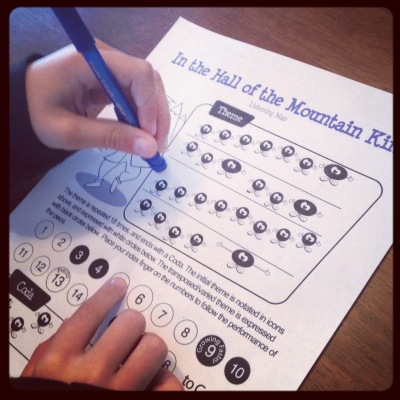
Two years ago (wow, I've been blogging that long now!) I posted a study of In The Hall of the Mountain King, by Edvard Grieg.
This weekend I revisited the lesson to prepare for teaching it again to my children. It never ceases to amaze me how much they love this piece of music and how we all hum it INCESSANTLY after just one listening.
So much is to be learned from this piece, too.
Why not use In The Hall of the Mountain King as your SQUILT this week?
If you're not familiar with Super Quiet UnInterrupted Listening time, visit my SQUILT page to find out more. Essentialy, it is an easy way to expose your children to great music and to encourage them to be critical listeners of music.
My kids have SQUILT each week, and this week when I turned on the music they both shouted "YES!" in unison. THAT is the reaction I want them to have to great masterpieces. (The music teacher in me was doign a huge happy dance.)
Please visit my original post about In The Hall of the Mountain King to listen to the music and learn some background on the story of the piece.
I'd like to encourage you today listen and then to just TALK about the elements on the SQUILT form -- Dynamics, Rhythm, Instrumentation, and Mood. After you do this, then present your children the listening map I will share with you. I think you'll find that following the listening map is an acceptable substitute for writing with this piece.
{Of course, you can have them fill out the form if you want, it's your homeschool!}
Dynamics
The piece starts very softly and grows in volume (the music crescendos). There is a main theme that is repeated SEVERAL times in the piece. Each time it is stated it gets louder and louder. This is what makes the piece so much fun!
Rhythm
The same rhythmic pattern is repeated EIGHTEEN times. Simple as that.
Instrumentation
A full symphony orchestra is used. In the beginning, when the theme is soft, there are few instruments and some solos. As the theme gets louder more instruments are added. Encourage your students to name the instruments they hear.
Mood
The piece is classified as "Incidental Music" to go along with the play Peer Gynt. In the Hall of the Mountain King is a part of The Peer Gynt Suite. The mood is dark and foreboding. Peer is being chased by trolls in the Hall of the Mountain King. My son was illustrating this today and it was cracking me up.
Both of my children loved following the listening map.
The map is self-explanatory. A non musician should have an easy time of guiding their children through it.
One bit of helpful information: a CODA is an ending section tacked onto a piece of music that doesn't fit the form of the rest of the piece. It sounds like the piece, but just a tad different.
Listen to the piece a few times before you give them the listening map - they will better be able to hear the theme and how it is repeated.
{Download the listening map for In The Hall of the Mountain King.}
Follow up for this lesson might include listening to the rest of the Peer Gynt Suite, notebooking about Grieg, or drawing a picture to go along with the music.


